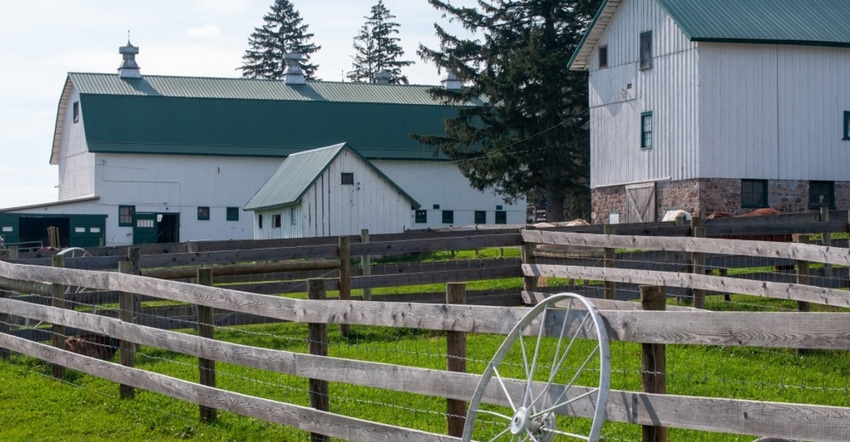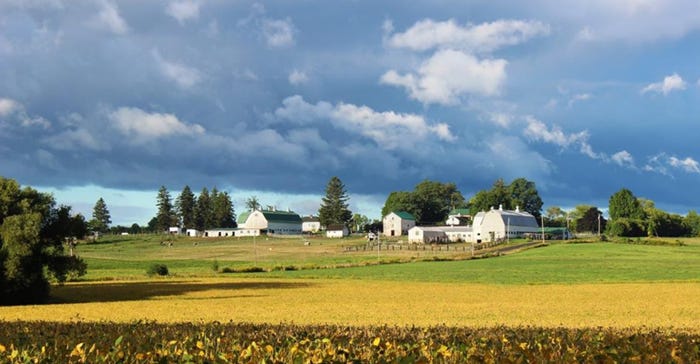March 16, 2022

Alasa Farms in North Rose, N.Y., is a special place, not only for providing a home for Cracker Box Palace, a farm animal rescue operation, but also in preserving a historic farm.
Listed on the New York State Register of Historic Places, the farm features a few barns dating back to the 1820s. It is not only the age of the structures, but also how they were built and used that make them exceptional.
“You can’t build barns like they used to,” says Sara Buys, farm director since 2020. “I have friends who have put up brand-new pole barns and have tons of problems. We’re in 200-year-old barns that are so sturdy and stable, even the structure of the wood and how dense it is. The timber they have now for lumber is so thin. It breaks so easy. Our barns are just solid.”
The farm’s Shaker barn, main house and deacon’s house were built in the early 1800s. Other historic buildings on the property date back to the 1920s.
The West Barn is a historic bank-style barn. Now used to quarantine sick animals, this barn once housed prized Belgian workhorses, and at one point was a home to American Shorthorn milking cattle.
“We have display cases of hundreds of ribbons from their bull in the 1920s,” Buys says.
The Horse Barn was built in the early 1800s and currently houses 20 rescue horses. The hay chutes allow workers to disperse hay from the mow directly into the hay rack in each stall.

Alasa Farms is listed on the New York State Register of Historic Places for its barns and other structures that date back to the early 1800s. It is home to Cracker Box Palace, a farm animal rehab and rescue organization.
The barn still has its original plumbing for an automatic watering system. Unfortunately, for the staff of eight and the volunteers who help, these no longer work as years of rust rendered them inoperable. The pipes were left in place to show how advanced Alasa Farms was in its day. The Horse Barn was originally a breeding barn for Hackney ponies.
“We have a few of the remaining bloodlines of those horses,” Buys says. “They were willed to Alasa Farms because the owner wanted them to live here.”
The large structure includes a buried basement with Jamesway vents on the top.
“With the stalls in the basement, it stays 40 degrees, even in the winter, because of how it’s set up,” Buys says. “It’s amazing how much they knew what to do 100 years ago that people still don’t know and do today.”
The barn also has its original motor for the door, although it is no longer in service. Rather than opening the door, the motor electrified the door to zap pesky bugs.
The barn also featured a pully system that used Belgian workhorses to pull the door up and down, and platforms in the hay mow to move hay on a track to each chute.
The Cow Barn is like the Horse Barn, but with stanchions. Currently, the shelter uses it for quarantining goats and sheep that are new, sick or elderly.
Another structure on the property from the 1920s is a silo made of cement, stone and mortar.
“Some stone was from Second Creek that runs through the farm,” Buys says. “You can see some fossils in the stonework. They did the same thing with the smaller barn that was a pig barn. We call it the Shaker Barn.”
That structure is for the farm’s “old lady horses,” who need their own area. The Shaker Barn has also been used for pig rendering and for lambing.
Rich history
Judge John Nicholas, originally of Virginia, built the first settlement on what is now Alasa Farms in the early 1800s. His heirs sold the property in 1826 to Sodus Bay Shakers. A decade later, the Sodus Bay Canal Co. purchased the site because of its access to Sodus Bay. They hoped to link Sodus Bay with the Erie Canal, but were unsuccessful.
A few other groups interested in communal living purchased and sold the farm for numerous years, as its many buildings and resources made it a true farmstead capable of supporting a few families.
The farm’s name stems from its new owners in 1926, Alvah Strong and Asa McBride. Eventually, the Strong family bought out the other owners.
In 2003, owner Griff Mangan offered space at the farm for Cracker Box Palace’s growing number of rescued animals. A nonprofit was formed to take over the farm’s ownership and management, as well as continue to care for animals.
“It’s all about preservation, keeping the farm in its original state so it will never become a development,” Buys says. “With 627 acres, it would be easy to put a lot of houses on it.”
In addition to more modern buildings, the farm also includes a house built in the 1820s by the Shakers, a religious group prominent in the area during that time; a bunkhouse for bachelor farmhands (now for farm interns); the Deacon’s House, built in the 1800s; and two tenant houses, one of which Buys lives in.
Because many of the farm’s buildings are on the registry, major replacements such as a roof require consulting with the New York State Register of Historic Places. Alasa also works with Crawford and Stearns, an architectural firm in New York that consults on historic preservation and restoration projects.
The farm’s historic committee, comprised of people passionate about history and Alasa Farms, is also involved in decision making.
“Everything has and is and will continue to be agricultural,” Buys says.
The farm leases property to local farmers for growing soybeans and corn, and uses some of its land for trail riding and making hay for animals. The farm raises apple and peach trees with a local farmer tending them.
About 185 animals live at the no-kill shelter, which takes in abused, neglected and otherwise surrendered farm animals, including horses, pigs, goats, rabbits, chickens, roosters, fowl, sheep and cows.
Sergeant writes from central New York.
About the Author(s)
You May Also Like




